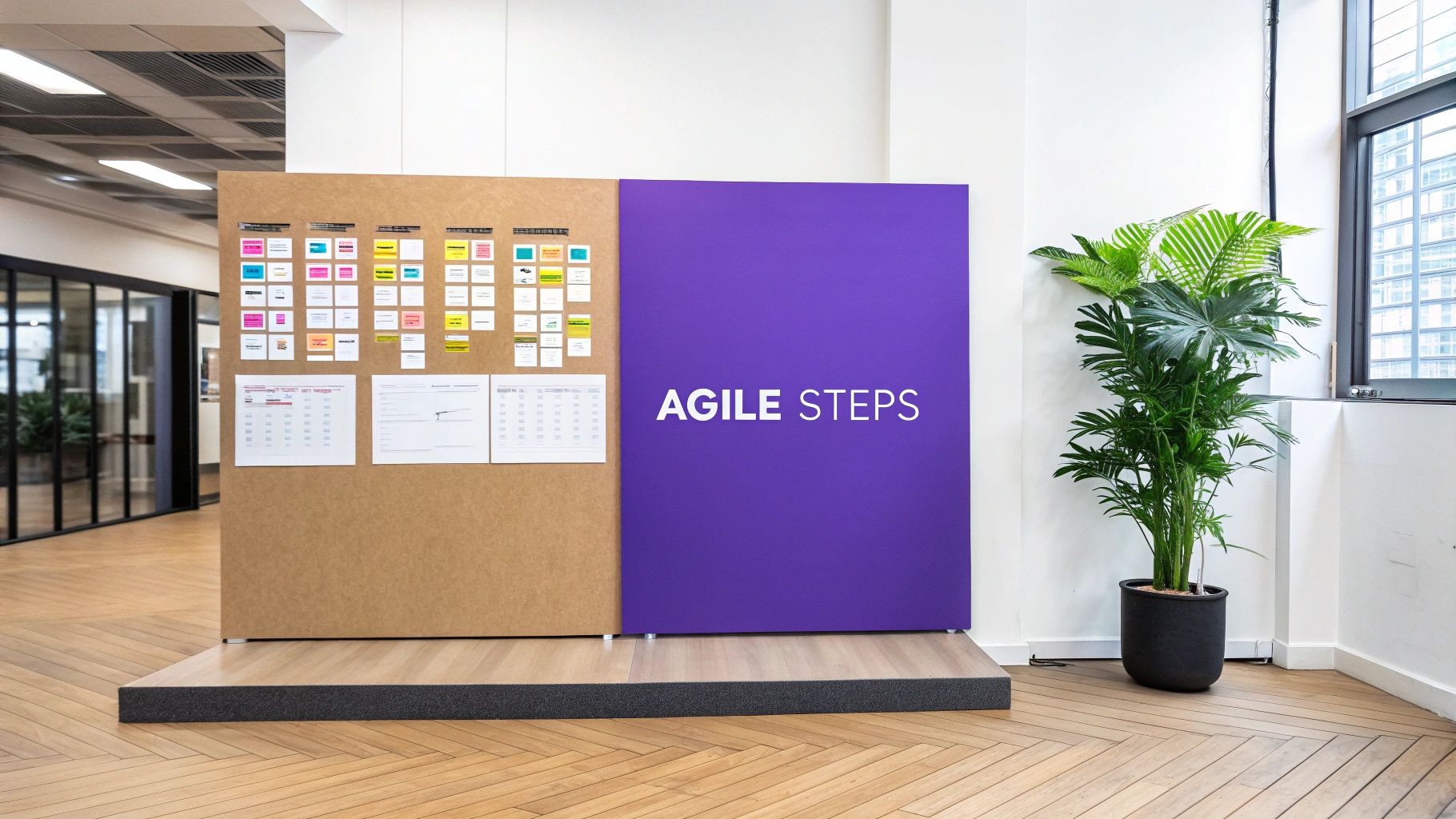The New Reality of Remote Product Development

Remote product development has quickly become a powerful strategy. What started as a temporary solution during the pandemic has evolved into a fundamental shift in how products are developed and launched. Leading organizations are embracing remote-first approaches, recognizing their potential not just for survival, but for significant growth. Why is this model gaining such traction?
Accessing Global Talent and Accelerating Innovation
A major advantage of remote product development is the ability to tap into a global talent pool. Companies are no longer limited by geography and can recruit the best talent worldwide. This access to diverse perspectives and specialized skills significantly boosts innovation and accelerates product development.
Imagine a design team in Europe, engineers in Asia, and product managers in North America, all collaborating seamlessly on a single project. This distributed model can create a 24/7 development cycle, drastically reducing time-to-market.
The global adoption of remote work has also surged across diverse industries. In 2023, approximately 28% of employees globally worked remotely, a significant jump from 20% in 2020. This growth reflects the increasing recognition of remote work as a strategic imperative. Platforms like Virtual Vocations published over 213,000 fully remote job postings in 2023 from more than 10,870 companies, showcasing the rising demand for remote talent. For a deeper dive into these trends, check out these remote work statistics. This shift is transforming how companies handle talent acquisition and retention.
To illustrate the impact of remote work across different sectors, let's look at the following table:
Remote Work Adoption Across Industries
This table compares remote work adoption rates and their effects on product development across different sectors.
| Industry | Remote Work Adoption Rate | Key Benefits | Common Challenges |
|---|---|---|---|
| Technology | High (estimated 60%+) | Increased access to specialized talent, faster development cycles | Maintaining company culture, security concerns |
| Finance | Moderate (estimated 40-50%) | Reduced overhead costs, improved work-life balance for employees | Data security and regulatory compliance |
| Healthcare | Moderate (estimated 30-40%) | Increased flexibility for healthcare professionals, improved access to care in remote areas | Ensuring patient privacy and data security, reliable technology access |
| Education | Moderate (estimated 30-40%) | Personalized learning experiences, increased access to educational resources | Digital divide, maintaining student engagement |
| Manufacturing | Low (estimated 10-20%) | Increased automation and remote monitoring, improved efficiency | Limited applicability for hands-on tasks, need for robust cybersecurity infrastructure |
The table highlights how industries are adapting to remote work at varying paces. While technology leads the way, other sectors are catching up, driven by the benefits of flexibility and access to a wider talent pool. Addressing the challenges, such as security concerns and maintaining company culture, is crucial for successful remote product development.
Building More Resilient Teams Through Flexibility
Remote product development fosters more resilient and adaptable teams. This flexibility enables companies to respond effectively to shifting market dynamics and evolving customer needs. This agility is a major competitive advantage in today's fast-paced environment. By using asynchronous communication and collaboration tools, teams can maintain productivity and momentum, regardless of location or time zone.
The Shift Towards Asynchronous Ideation
Another significant benefit is the rise of asynchronous communication and ideation. Traditional brainstorming sessions, often restricted by time and place, are evolving into flexible, ongoing digital discussions. This empowers team members to contribute ideas when they're most productive, fostering more diverse and innovative solutions.
This asynchronous approach recognizes that not everyone thrives in the same environment and allows individuals to contribute effectively in their preferred way. It removes the pressure of real-time idea generation, encourages more thoughtful contributions, and reduces the risk of groupthink. Asynchronous communication also creates a more inclusive environment, where everyone feels comfortable sharing ideas, regardless of their personality or communication style. The result? Better products and a more engaged, productive team.
Building High-Performing Remote Product Teams
Building a remote team isn't just about allowing employees to work from home. It's about cultivating a high-performing unit that thrives in a distributed setting. This involves a shift in mindset, going beyond traditional management styles and embracing strategies tailored for remote product development. A critical aspect is selecting individuals with the right technical skills and the essential soft skills needed for remote work.
Identifying Key Traits for Remote Success
Successful remote team members possess a blend of technical expertise and soft skills vital for a distributed environment. Self-discipline, strong communication skills, and proactive problem-solving are essential. Look for candidates with a proven track record of independent work, clear communication across various platforms, and the ability to handle challenges without constant supervision.
- Self-Discipline: Can individuals manage their time and workload independently?
- Communication Proficiency: Are they clear and responsive communicators across various platforms like Slack?
- Proactive Problem-Solving: Can they identify and tackle challenges independently, escalating issues when necessary?
- Collaboration and Teamwork: Do they contribute positively to team dynamics and collaborate effectively in a virtual workspace?
Structuring Distributed Teams for Optimal Performance
With the right people in place, structuring your team effectively is crucial for optimal performance. Define clear roles and responsibilities that translate well to a remote environment. Establish communication protocols and workflows that facilitate seamless collaboration, regardless of location. Check out resources like this guide on managing distributed teams for helpful insights.
For example, consider smaller, cross-functional teams with clearly defined ownership of specific product areas. This can boost accountability and streamline decisions.
Creating Accountability Without Micromanagement
Accountability is key for any team, but remote settings require a different approach. Instead of constant monitoring, focus on output and results. Set clear expectations, establish measurable goals, and use project management tools like Asana for transparency. This builds trust and ownership, encouraging responsibility for individual contributions.
Regular check-ins focusing on achievements and obstacles maintain alignment without hindering autonomy. This approach shifts the focus from tracking activity to measuring impact, fostering a positive and productive environment. This article offers valuable perspective on the changing nature of work.
Fostering Psychological Safety in Digital Spaces
A psychologically safe environment is crucial for remote teams. It means fostering a culture where team members feel comfortable taking risks, sharing ideas, and voicing concerns without fear of judgment. This is essential for open communication, collaboration, and innovation.
Achieve this through transparent communication, regular team-building, and active listening from leadership. Encourage feedback and create informal interaction opportunities to strengthen team bonds.
Remote work, especially in tech, has grown significantly. As of 2023, 67.8% of the tech workforce is fully or mostly remote, driven by flexibility and productivity gains. Learn more about these remote work trends. This trend is expected to continue, impacting how companies access global talent.
Onboarding and Team Cohesion
Effective onboarding integrates new remote team members seamlessly. Develop structured programs that introduce new hires to the team, company culture, and remote tools and processes. This helps them become productive quickly and feel connected.
Pair new hires with experienced mentors for initial guidance and support. Organize virtual team-building activities to foster connection and build rapport despite physical distance. These could include online games, virtual coffee breaks, or shared online learning. Prioritizing onboarding and team cohesion builds a foundation for a successful and engaged remote workforce.
Tech Stack That Powers Remote Product Excellence

Building high-performing remote product teams takes more than just talented people. It requires a solid and well-integrated tech stack. This digital infrastructure allows for smooth collaboration, streamlines workflows, and ultimately drives product excellence, no matter where your team members are located. It's not about chasing the newest gadgets; it's about strategically choosing and integrating systems that empower your team to reach its goals.
Essential Tools For Remote Product Development
Effective remote product development hinges on a connected set of tools that address core areas like collaboration, communication, and project management. Picking the right tools can significantly smooth out the bumps in the road and improve productivity.
To illustrate the variety of tools available and considerations for implementation, let's look at the following table.
Essential Tool Categories for Remote Product Development
Comprehensive breakdown of software tools that enable effective remote product development processes
| Tool Category | Key Features | Popular Solutions | Implementation Considerations |
|---|---|---|---|
| Communication & Collaboration | Real-time messaging, file sharing, video conferencing | Slack, Microsoft Teams, Google Workspace | Team communication style, security needs, integration with other tools |
| Project Management | Task management, progress tracking, sprint planning | Asana, Jira, Trello | Project complexity, team size, reporting requirements |
| Design & Prototyping | Collaborative design, wireframing, prototyping | Figma, Adobe XD | Designer preferences, fidelity of prototypes needed, integration with development tools |
| Code Collaboration & Version Control | Code sharing, version control, code reviews | GitHub, GitLab | Development workflow, codebase size, security needs |
| Knowledge Management & Documentation | Centralized documentation, knowledge bases, best practice sharing | Notion, Confluence | Team knowledge sharing habits, ease of use, search functionality |
This table highlights the categories of tools essential for remote product development and some popular solutions. When implementing, consider your team's specific needs and the complexity of your projects.
Building An Integrated Ecosystem
The real strength of a remote tech stack lies in its integration. A well-integrated ecosystem reduces context switching, breaks down information silos, and streamlines workflows. For example, connecting your project management tool with your communication platform can automatically notify teams about task progress, saving time on manual updates.
Balancing Standardization And Flexibility
While standardization promotes consistency and efficiency, it's vital to balance it with flexibility. Different teams may have specific requirements and preferences, so allow for some customization within the overall tech stack. This approach allows teams to choose tools that best suit their workflows, promoting both efficiency and team satisfaction.
For example, a marketing team might prefer a visual project management tool, while a development team might opt for a more code-centric platform. Accommodating these variations within a standardized framework can boost productivity across the entire organization.
Choosing The Right Tools For Your Team
There's no one-size-fits-all answer when it comes to choosing tools. Consider your team’s specific needs, workflows, and budget. Prioritize user-friendliness and ease of integration to make sure the tools are adopted and used effectively. Do your research, try out different options, and get feedback from your team to make smart decisions that drive remote product excellence.
Remote product development has also seen advancements with technology, especially in AI and automation. Tools like Copilot are automating tasks, freeing up teams to focus on higher-level work. Development observability tools help measure productivity accurately. Learn more about the future of remote work at Software.com.
This careful selection and integration of your tech stack ensures technology supports your remote product development journey. The result? A more efficient, connected, and successful remote team.
Reimagining Agile for Distributed Teams
Traditional Agile methodologies, designed for co-located teams, often face challenges in the world of remote product development. Simply transferring in-person practices to a digital environment isn't effective. Successful remote teams are adapting Agile principles to better suit the realities of distributed work. This involves re-evaluating how teams communicate, collaborate, and maintain momentum across different time zones and locations.
Adapting Agile Ceremonies for Remote Environments
Standard Agile ceremonies, such as daily stand-ups and sprint planning, require a remote-friendly approach. For example, instead of requiring everyone to participate in a daily video call, consider asynchronous daily updates. Teams can utilize tools like Slack or project management software to share their daily progress, roadblocks, and plans. This respects everyone's time and promotes more focused work. Similarly, sprint planning can be adapted into a hybrid approach, combining asynchronous preparation with shorter, more focused synchronous sessions for discussions and decision-making.
This transition to asynchronous communication can significantly improve the effectiveness of Agile ceremonies. It empowers team members to contribute when they are most productive, creating a more inclusive and efficient workflow. It also encourages more thoughtful input and reduces the chance of groupthink, ultimately leading to better results.
Visualizing Work and Maintaining Momentum Digitally
One of the key challenges of remote product development is the absence of physical whiteboards and visual aids. Fortunately, many digital tools offer excellent alternatives. Platforms like Miro and Mural allow teams to visualize their work, collaborate on diagrams, and monitor progress in a shared digital workspace. These tools can be used for various activities, including brainstorming, sprint planning, and even remote design thinking workshops.
Maintaining momentum between synchronous interactions is also essential for remote Agile teams. Clear communication, shared objectives, and well-defined tasks help bridge the gaps. Regular asynchronous check-ins and status updates ensure everyone remains aligned and focused. Tools like Bulby can be especially helpful for facilitating brainstorming and ideation sessions, encouraging participation from all team members, regardless of their location.
Fostering Spontaneous Collaboration in a Distributed World
While structured meetings are important, spontaneous collaboration often leads to breakthroughs. In a traditional office, this might occur during casual conversations or impromptu discussions. Remote teams need to create opportunities for these informal interactions as well. This could involve scheduling virtual coffee breaks, establishing dedicated Slack channels for social interaction, or using tools that facilitate quick video calls and screen sharing.
By adapting Agile ceremonies, embracing digital visualization tools, and promoting spontaneous collaboration, remote product development teams can leverage the advantages of Agile while addressing the challenges of a distributed environment. This creates a more flexible, inclusive, and ultimately, a more productive way of working.
Communication Mastery in Remote Product Teams

Communication is essential for any team. But when your product team is spread across different time zones and countries, it becomes even more vital. Effective communication can be the difference between a successful, innovative team and one that struggles with misunderstandings and missed deadlines. But this doesn't have to be your team's reality. With the right approach, remote product teams can not only survive but truly thrive.
Synchronous Vs. Asynchronous Communication: Finding the Right Balance
One of the biggest changes in remote product development is understanding how to use both synchronous and asynchronous communication. Synchronous communication, like video calls, happens in real time. Asynchronous communication, such as email or using messaging platforms like Slack, occurs over a period of time. Knowing when to use each method is key to remote team success.
For urgent issues or complex topics that need immediate feedback, synchronous communication is the best choice. But for regular updates, project planning, or brainstorming, asynchronous communication can be more productive. This allows team members to contribute when they're most focused, leading to better results. You might also be interested in: How to master remote collaboration.
This balanced approach reduces meeting fatigue, helps maintain focus, and respects different work styles. It recognizes that not everyone excels in real-time discussions and provides the opportunity for more thoughtful input.
Documentation: The Cornerstone of Clarity
Well-maintained and easy-to-access documentation is the foundation of successful remote product development. Documenting decisions, requirements, and processes ensures that everyone has access to the same information, no matter where they are or what their time zone is. This prevents confusion, minimizes errors, and creates a single source of truth for the team.
Think of documentation as a constantly updated guide for the product development process. It’s a valuable tool that keeps teams on the same page and reduces the need for repetitive questions.
Effective Remote Meetings: Maximizing Productivity
Even though asynchronous communication is important, remote meetings are still necessary for team connection and collaboration. However, meetings need to be well-planned and executed to avoid wasting time and causing frustration. Set clear objectives, create agendas, and share them ahead of time. Keep the meeting focused on the agenda and encourage active participation from all team members. Using tools like Bulby can improve brainstorming and idea generation in remote meetings, making sure everyone's voice is heard.
Inclusive Communication Across Cultures and Time Zones
Remote teams often consist of individuals from various cultures and time zones. This creates specific communication challenges. Be aware of cultural nuances in communication styles, and prioritize clear and respectful communication. When planning meetings, find times that accommodate everyone, if possible. Rotate meeting times to share the burden across different time zones. Recording and sharing meetings allows those unable to attend live to stay informed.
Building Communication Rituals That Strengthen Teams
Beyond the functional side of communication, establishing team rituals can enhance connections and boost team morale. These could be as simple as a weekly virtual coffee break or a monthly online team-building event. These opportunities for casual interaction help remote team members build relationships and create a sense of community.
Developing strong communication habits empowers remote product teams to bridge the distance. By mastering these strategies, teams can improve collaboration, encourage innovation, and build exceptional products.
Maintaining Product Quality Across Distances
Maintaining high product quality is non-negotiable for any successful product. This becomes even more challenging with geographically dispersed teams. However, with the right strategies and tools, remote teams can not only maintain but enhance product quality.
Establishing Clear Quality Standards and Automated Testing
One cornerstone of maintaining quality in remote product development is establishing clear, measurable quality standards. These standards should be accessible to all team members and serve as a guiding principle throughout development.
Implementing automated testing frameworks is crucial. Catching bugs early reduces reliance on manual testing and improves efficiency. This ensures consistent quality across locations and minimizes errors.
For example, define acceptance criteria for each feature, outlining what constitutes successful implementation. Automated tests, integrated into the workflow, verify these criteria before code is merged.
Effective Remote Code Reviews and Security Protocols
Clear communication is paramount for effective remote code reviews. Using collaborative code review tools with commenting and feedback features ensures thorough examination, identifies vulnerabilities, and promotes consistent best practices. Consider working on your team's strategic communication skills to boost remote collaboration.
Security protocols are even more critical in remote environments. Implementing robust security measures safeguards sensitive data and intellectual property.
These measures might include secure code repositories, multi-factor authentication, and regular security audits. This minimizes risks associated with distributed teams and ensures the security of the development process.
Gathering and Implementing User Feedback Across Time Zones
Collecting user feedback is vital in a remote context. Using online survey tools, remote user testing platforms, and feedback management systems allows teams to gather feedback efficiently across time zones.
This provides valuable insights into product performance and usability in diverse real-world scenarios. Integrating this feedback ensures the product meets user expectations and addresses any cultural or regional needs. This iterative feedback loop creates a robust quality assurance process for distributed teams.
Building a Scalable Quality Assurance Process for Distributed Teams
Quality assurance (QA) in remote product development requires a scalable approach. A dedicated QA team with members in various time zones allows for continuous testing and quicker feedback loops.
This 24/7 QA process ensures issues are identified and addressed promptly. For more information on managing remote teams effectively, check out this article on remote project management tools.
By implementing these strategies, remote teams can ensure product quality isn't compromised by distance. This proactive approach, combined with strong communication, builds a foundation for successful product development, regardless of location.
Overcoming the Real Challenges of Remote Product Teams

While remote product development offers many advantages, it also presents unique challenges. If not addressed effectively, these can hinder team productivity, decrease morale, and ultimately impact product quality. This section explores these common obstacles and offers practical solutions.
Communication Breakdowns and the Importance of Clarity
One of the biggest challenges in remote product development is the potential for communication breakdowns. Without in-person interaction, misinterpretations and missed cues can easily happen. This can lead to misunderstandings about project requirements, deadlines, and priorities. Different communication styles and cultural nuances can further complicate things.
To address this, establish clear communication protocols and encourage open dialogue. Utilize a variety of communication channels.
- Instant messaging for quick questions
- Video conferencing for complex discussions
- Project management software for tracking progress and updates
For example, a team might use Slack for daily communication, Zoom for weekly team meetings, and Asana for managing tasks and projects. This multifaceted approach ensures clarity and minimizes miscommunication.
Combating Isolation and Fostering Connection
Remote work can sometimes lead to feelings of isolation. This lack of social interaction can negatively impact morale and decrease collaboration. Intentional efforts to build connections can help mitigate this.
Regular virtual team-building activities can foster camaraderie.
- Online games
- Virtual coffee breaks
- Shared online learning experiences
Encouraging informal communication and creating opportunities for social interaction outside of project discussions builds rapport and strengthens team bonds. This creates a more supportive and engaging work environment. It helps remote team members feel valued and connected, increasing job satisfaction and overall team performance.
Addressing Conflict Effectively in a Virtual Setting
Resolving conflict effectively can be more challenging remotely. The absence of in-person cues and body language makes it difficult to gauge emotions and understand perspectives. Communication delays can exacerbate tensions and prolong disagreements.
To address conflicts constructively, encourage open and honest communication. Facilitate virtual meetings to discuss the issue and allow all parties to express their viewpoints. Active listening and empathy are crucial for understanding the root cause and finding mutually acceptable solutions.
Implementing clear conflict resolution processes helps maintain a positive team dynamic. This ensures disagreements are addressed promptly and professionally. This proactive approach minimizes the negative impact of conflicts and contributes to a healthier, more productive remote work environment.
Maintaining Creativity and Spontaneous Collaboration
While asynchronous communication has benefits, it can limit spontaneous collaboration and brainstorming. These are essential for generating new ideas and solving complex problems.
One highly effective approach is asynchronous ideation. This process moves away from traditional long ideation meetings and instead uses a multi-step approach that caters to different needs and encourages reflection. The together time is then used for discussing pre-generated ideas, creating a more productive, less stressful environment.
This shift in focus allows for more thoughtful contributions and ultimately better ideas. By recognizing that ideation is a process, not just a meeting, remote teams can unlock greater creativity.
Preventing Burnout and Promoting Well-Being
Remote work can blur the lines between work and personal life, potentially leading to burnout. Encouraging a healthy work-life balance is crucial for maintaining team well-being and preventing exhaustion.
Promoting flexible work schedules, encouraging regular breaks, and advocating for time off are essential. Providing resources and support for mental health and well-being can significantly contribute to a healthier and more sustainable remote work environment.
By actively addressing these challenges, organizations can build thriving remote product teams that are not only productive but also engaged and fulfilled. This proactive approach ensures remote work enhances, rather than hinders, overall success.
Start boosting your team's creativity and collaboration today with Bulby, the brainstorming tool designed for remote teams.

